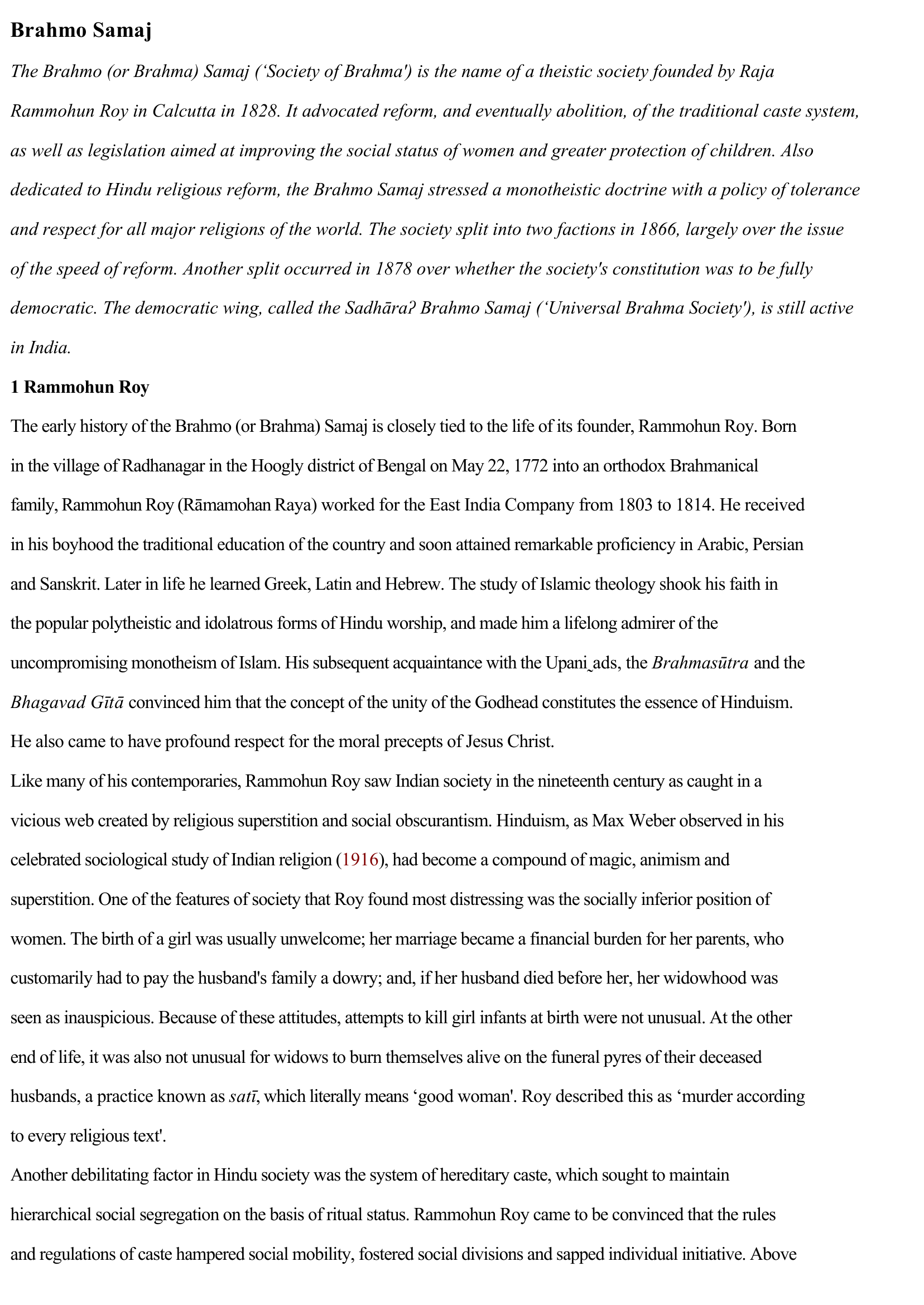Brahmo Samaj
Extrait du document
«
Brahmo Samaj
The Brahmo (or Brahma) Samaj (‘Society of Brahma') is the name of a theistic society founded by Raja
Rammohun Roy in Calcutta in 1828.
It advocated reform, and eventually abolition, of the traditional caste system,
as well as legislation aimed at improving the social status of women and greater protection of children.
Also
dedicated to Hindu religious reform, the Brahmo Samaj stressed a monotheistic doctrine with a policy of tolerance
and respect for all major religions of the world.
The society split into two factions in 1866, largely over the issue
of the speed of reform.
Another split occurred in 1878 over whether the society's constitution was to be fully
democratic.
The democratic wing, called the Sadhāraʔ Brahmo Samaj (‘Universal Brahma Society'), is still active
in India.
1 Rammohun Roy
The early history of the Brahmo (or Brahma) Samaj is closely tied to the life of its founder, Rammohun Roy.
Born
in the village of Radhanagar in the Hoogly district of Bengal on May 22, 1772 into an orthodox Brahmanical
family, Rammohun Roy (Rāmamohan Raya) worked for the East India Company from 1803 to 1814.
He received
in his boyhood the traditional education of the country and soon attained remarkable proficiency in Arabic, Persian
and Sanskrit.
Later in life he learned Greek, Latin and Hebrew.
The study of Islamic theology shook his faith in
the popular polytheistic and idolatrous forms of Hindu worship, and made him a lifelong admirer of the
uncompromising monotheism of Islam.
His subsequent acquaintance with the Upani˷ads, the Brahmasūtra and the
Bhagavad Gītā convinced him that the concept of the unity of the Godhead constitutes the essence of Hinduism.
He also came to have profound respect for the moral precepts of Jesus Christ.
Like many of his contemporaries, Rammohun Roy saw Indian society in the nineteenth century as caught in a
vicious web created by religious superstition and social obscurantism.
Hinduism, as Max Weber observed in his
celebrated sociological study of Indian religion (1916), had become a compound of magic, animism and
superstition.
One of the features of society that Roy found most distressing was the socially inferior position of
women.
The birth of a girl was usually unwelcome; her marriage became a financial burden for her parents, who
customarily had to pay the husband's family a dowry; and, if her husband died before her, her widowhood was
seen as inauspicious.
Because of these attitudes, attempts to kill girl infants at birth were not unusual.
At the other
end of life, it was also not unusual for widows to burn themselves alive on the funeral pyres of their deceased
husbands, a practice known as satī, which literally means ‘good woman'.
Roy described this as ‘murder according
to every religious text'.
Another debilitating factor in Hindu society was the system of hereditary caste, which sought to maintain
hierarchical social segregation on the basis of ritual status.
Rammohun Roy came to be convinced that the rules
and regulations of caste hampered social mobility, fostered social divisions and sapped individual initiative.
Above.
»
↓↓↓ APERÇU DU DOCUMENT ↓↓↓

































